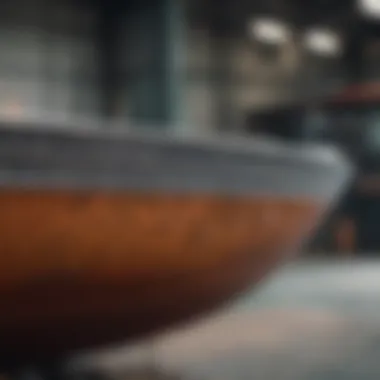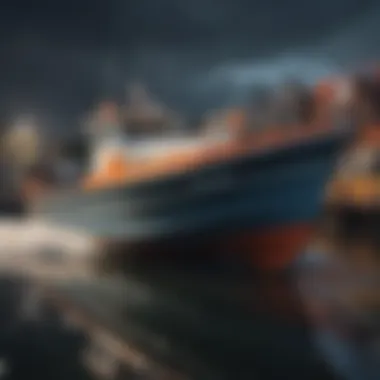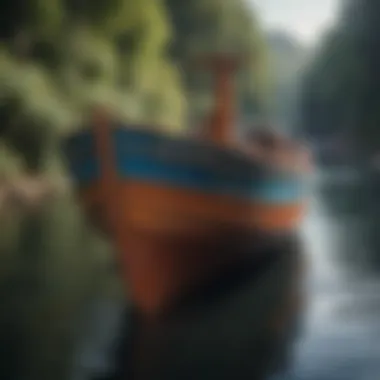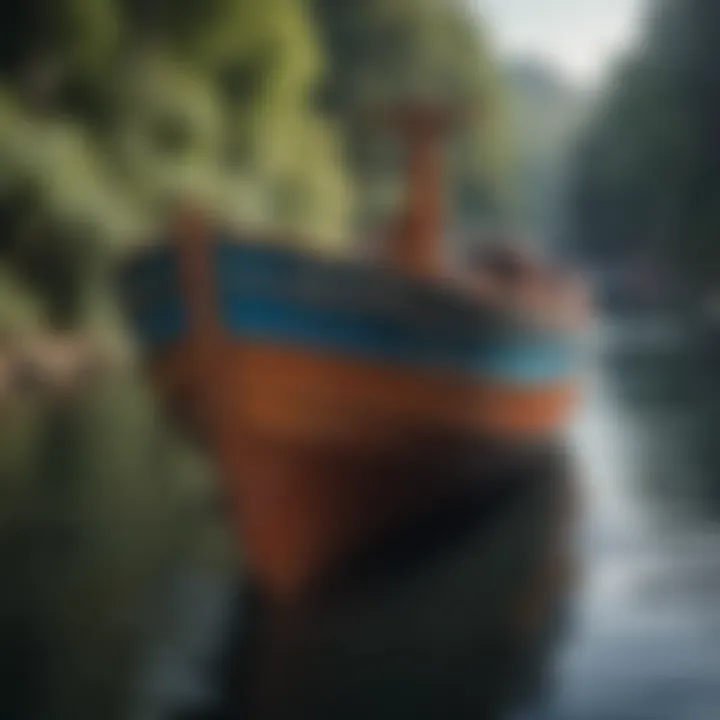Understanding Metal Boat Paint: A Complete Guide


Intro
Metal boats, whether for leisure or professional use, come with their share of maintenance hurdles. Among these, one of the paramount concerns is the paint that protects these vessels. Painting metal boats isn't just an aesthetic endeavor; it's a shield against corrosion, can enhance performance, and contributes significantly to longevity.
In this exploration, we’ll break down the essence of metal boat paint, shedding light on its various facets. We’ll cover what makes a paint suitable for metal, discuss the intricacies of application, and delve into maintenance practices that ensure your vessel remains in tip-top shape. With the right knowledge, boat owners can make informed choices that will tailor their approach to their specific needs.
Key Concepts
Definition of Primary Terms
To grasp the subject fully, it’s crucial to understand some key terminologies:
- Anti-fouling paint: This type of coating prevents marine organisms from attaching to your boat's hull. It’s especially important for vessels used in saltwater.
- Barrier coat: An intermediary layer that helps protect the boat's surface from moisture and corrosion, acting as a link between the hull and the final topcoat.
- Elastomeric paint: A flexible paint that can expand and contract with the vessel's movement, useful for minimizing cracks and peeling.
These terms form the backbone of our discussion and highlight the various options boat owners have when deciding on paints.
Related Concepts and Theories
Understanding metal boat paints also brings in related theories such as surface preparation methods and material interactions with the environment. While it might seem intuitive to just slap on a coat of paint, preparation is key. The process can involve:
- Sanding or stripping old paint layers
- Conducting thorough cleaning to remove all contaminants
- Checking for wear and tear on the surface
All these steps contribute to creating a robust base for painting. A poor application can lead to misleading perceptions about the quality of the paint itself, thus impacting the boat's overall longevity.
"Proper surface preparation is half the battle won in achieving a durable and effective paint job."
Future Directions
Gaps Identified in Current Research
Research is continuously evolving. Although we've made strides in understanding the properties of various metal boat paints, there's still a yawning gap in comprehensive studies that tackle their long-term effects in distinct environments. For instance, how does a specific paint react over time in fluctuating temperatures? Or, what is the performance of emerging eco-friendly paint options?
Suggestions for Further Studies
To further enhance our grasp on metal boat paints, future studies should:
- Focus on long-term exposure effects of different paint types specific to varied climates.
- Investigate biodegradable and less toxic paint chemicals that could reduce environmental harm.
- Explore innovative application techniques that would reduce waste and improve coverage precision.
By addressing these points, not only can we improve the industry standards, but we can also equip boat owners with better tools for maintaining their vessels in an environmentally conscious manner.
Prologue to Metal Boat Paint
Painting a metal boat isn’t just an aesthetic choice; it serves numerous functional purposes that can’t be overlooked. Whether you're a seasoned sailor or a weekend warrior, the right paint can make a world of difference in how your vessel performs and endures the rigors of marine life. This section delves into the significance of using the proper paint, particularly focusing on durability, protection, and overall maintenance of your boat.
Importance of Painting Metal Boats
While it may seem like just a splash of color, metal boat paint holds critical value. First, it acts as a protective barrier against the elements that wreak havoc on bare metal. Saltwater, UV rays, and even freshwater can introduce corrosion, which threatens the integrity of your boat. Painting creates a shield, helping to stave off rust and degradation from prolonged exposure.
But the benefits do not end there. A well-chosen and properly-applied paint can significantly enhance the boat’s aesthetic appeal, potentially increasing its market value. Bright colors and sleek finishes can attract attention, making your vessel stand out in a marina or on the open water.
Furthermore, paint can also influence the boat’s performance. Some specially formulated paints can effectively reduce drag in the water, leading to faster speeds and better fuel efficiency. A nuanced understanding of metal boat paints can thus equip boat owners with the knowledge to elevate functionality and appearance all at once.
Overview of Common Issues
Diving deeper into the realm of metal boat painting, it’s crucial to acknowledge the challenges that come with this undertaking. First off, the paint can peel when it hasn't adhered properly to the underlying surface. This peeling is often due to moisture trapped beneath the paint layer or improper cleaning before application.
Another prevalent concern is blistering. This occurs when air or moisture gets trapped under the paint, leading to bubbles or blisters on the surface. In addition, fading and discoloration can spoil the vibrant colors that initially delighted boat owners. Often caused by extensive sun exposure, fading not only detracts from the beauty of the boat but also can signal that the protective qualities of the paint are waning.
Addressing these issues involves foresight and proactivity. Regular maintenance and inspection can mitigate these problems, keeping your boat looking sharp and functional. Understanding these common pitfalls serves as a foundation for making informed decisions throughout the painting process, ultimately helping boat enthusiasts achieve greater satisfaction in their maritime endeavors.
"Investing time and effort into proper painting techniques and regular maintenance can extend the life of your metal boat significantly."
In summary, painting a metal boat is not just an exercise in aesthetics; it's a fundamental element of boat upkeep. Selecting the right paints and understanding the potential pitfalls pave the way for a successful outcome, allowing enthusiasts to showcase their vessels while ensuring longevity and performance.
Types of Metal Boat Paint
When it comes to painting metal boats, the type of paint you use can make all the difference in the world. Selecting the right paint is crucial not just for aesthetics but also for ensuring durability and protection against harsh marine environments. Each type of metal boat paint has its specific advantages, making it important to understand these variations. Let's delve into the main categories of metal boat paint and their characteristics, to guide you in making an informed decision for your vessel.
Alkyd Paints
Alkyd paints are somewhat like a trusted old friend in metal boat painting. They are oil-based and known for their smooth finish and good gloss retention. You might appreciate how easy they are to work with; just grab a brush or roller and start painting. They have solid adhesion to metal surfaces, providing a strong layer of protection.


However, alkyd paints tend to dry slower compared to others, so patience is key if you're looking for a perfect coat. Also, while they resist corrosion, they may not withstand the test of time as well as some other options, especially in harsher environments. If you're after a classic look, alkyd paints can deliver well, but you might find yourself redoing the job sooner than you'd hoped.
Epoxy Paints
Epoxy paints are definitely the heavyweights in the paint world. These paints are perfect for metal boats that face rough waters. They are formulated to create a hard, protective coating that repels moisture and prevents rust and corrosion like nothing else. One of the standout features of epoxy paints is their durability—they can take a real beating without flaking or peeling.
"Epoxy systems are a go-to choice for professional boat builders and maintenance experts alike."
On the flip side, applying epoxy paints requires some technical skill. They need a properly prepared surface and an exact mixing ratio to activate their features. If done right, the payoff is well worth the effort; you’ll have a robust finish that lasts for years. However, be prepared for strong fumes during application, so proper ventilation is a must.
Polyurethane Paints
Polyurethane paints come into play when you need a finish that shines bright and stands strong against UV rays. These paints are renowned for their glossy surface and resistance to fading, making them perfect for colorful boat aesthetics. Using them can make your boat stand out like a beacon on the water.
In terms of flexibility, polyurethane paints are pretty amazing as they can withstand impacts without cracking or chipping. However, the application process can be a bit tricky—too many layers can lead to issues, and getting the right consistency is crucial. As always, a well-prepared surface is key to getting that showroom shine.
Acrylic Paints
Acrylic paints are like the versatile all-rounders of the group. They dry quickly and are water-based, which means they’re easier to clean up after use. These paints offer a good level of protection against moisture and corrosion. They’re environment-friendly too, which makes them a choice congratulated by many.
Nevertheless, they might not be as tough as their epoxy or polyurethane counterparts. If you anticipate heavy usage and exposure, acrylic may require more frequent touch-ups. However, for those seeking ease of application and a decent finish, they certainly fit the bill.
Surface Preparation for Metal Boat Painting
Surface preparation is a vital step in achieving a successful painting job on metal boats. Without proper preparation, the longevity and effectiveness of the paint can be compromised. This process lays the groundwork, ensuring not just aesthetic appeal but also functional durability against environmental factors like saltwater, sun exposure, and fluctuating temperatures. To put it plainly, if you don’t prep the surface, you might as well toss your paint job out to sea.
Cleaning the Surface
Cleaning the surface is the first order of business when prepping for paint. It’s like trying to draw on a dirty window; nothing will stick well if the surface is coated in grime or salt. You should use a solution suitable for metal, such as mild soap and water, to scrub off any dirt, grease, or old paint residue. A pressure washer can also be particularly useful for larger boats, as it rapidly removes stubborn contaminants.
"A clean surface is the best canvas for your metal boat paint."
After cleaning, remember to rinse thoroughly. Leaving behind soap residues not only jeopardizes adhesion but can lead to unsightly stains as well. Once rinsed, let the surface dry completely before diving into the next phase of preparation.
Sanding and Abradive Techniques
Sanding serves as a bridge between a clean surface and paint adhesion. This step is often likened to roughing up the surface to ensure the new coat of paint can cling on for dear life. Use medium-grit sandpaper (around 120 to 220 grit), as it creates just enough texture. For larger, flatter areas, consider employing a power sander, which can save you significant time.
It's worth noting that there are various abradive techniques, like using an angle grinder or sanding discs, which can be more efficient on tougher spots. Also, make sure to wear appropriate safety gear, like masks and goggles, to protect against dust and debris, which can make for a nasty scene.
- Rough Up the Surface: This allows the paint to grip better.
- Remove Dust: After sanding, clean the surface again. Any residues left behind will dull the finish.
- Be Thorough: Pay special attention to tight corners or details where paint will have a harder time sticking.
Rust Treatment
Rust is like an unwelcome guest at a party; it creeps in and can ruin everything if left unchecked. Treating rust before applying any paint is non-negotiable. The first step is to identify any rust patches. A wire brush or sandpaper can help remove flaky rust, but don’t stop there. After you’ve scraped away the visible effect, consider treating the area with rust-inhibiting primer or remover. These materials can stop rust from coming back like a stubborn boomerang.
Once treated, give it some time to dry. It's essential that the areas you've worked on are treated well, so that your paint job can stick around for the long haul.
- Inspect for Rust: Like looking for cracks in a wall, ensure no spots are missed.
- Choose the Right Product: Use a rust converter if needed; this can chemically alter rust back into stable material.
- Final Layer: A rust-resistant primer can provide an additional defense layer before the final paint application.
Surface preparation, though often an overlooked aspect, is where the real magic begins. If you take these steps seriously, you’ll find yourself with a smooth, well-adhered coat of paint that can weather whatever Mother Nature throws at you.
Selecting the Right Paint for Your Metal Boat
Choosing the right paint for a metal boat is not just an aesthetic choice; it's a critical decision that goes a long way in preserving the vessel's integrity and functionality. Each type of paint has its own unique characteristics that cater to different environmental conditions and vessel requirements. Getting this part wrong can lead to significant repair costs and even affect safety at sea. This section aims to guide you through the essential elements that influence your choice of paint, highlighting the benefits of informed decisions.
Assessing Environmental Factors
When it comes to painting a metal boat, the local environment plays a crucial role in determining the best type of paint to use. Factors such as salinity in water, average temperature variations, and exposure to sunlight must be taken into account. For instance, if you're anchored in a coastal area with high saltwater exposure, you might want to consider a paint that offers greater corrosion resistance, such as epoxy-based options.
Some additional considerations include:
- Temperature Fluctuations: Paint that performs well in tropical conditions may not offer the same benefits in colder climates. Knowing your area’s climate patterns can greatly influence durability.
- UV Exposure: If your boat spends a lot of time docked in the sun, using UV-resistant paint can prevent fading and prolong the color life.
- Water Conditions: Lakes may not present the same biochemical and physical challenges that the ocean does. Each has its own set of needs, and it would be wise to choose paint tailored to these environments.
Assessing these elements is a foundational step in selecting the right paint, ensuring its longevity and effectiveness in protecting your metal boat.
Color and Aesthetic Considerations
While the technical aspects of metal boat paint are crucial, one cannot overlook the visual appeal. After all, a boat is often a personal reflection of its owner. Choosing the right color can make a statement and even improve visibility while navigating. Notably, bright colors can enhance safety through increased visibility, especially under cloudy skies or when viewed from a distance.
However, color can also influence the paint’s performance. Darker colors, for instance, tend to absorb more heat, which can affect the curing process and might even lead to thermal stress.
Here are some points worth considering:


- Color Psychology: Different colors convey different messages. Bright colors like yellow or red may scream adventure, while earth tones communicate a more subdued elegance.
- Future Maintenance: Lighter colors may show algae and dirt more than darker shades, necessitating more frequent cleaning.
- Resale Value: If you ever plan to sell the boat, consider what colors are appealing to the market. Neutral tones often attract a broader audience.
Ultimately, while aesthetic choices can certainly enhance your boat's looks, they should also take into account practical considerations to achieve a perfect harmony between beauty and function.
Application Techniques for Metal Boat Paint
When it comes to painting metal boats, the application technique is just as vital as the actual paint used. Proper application not only affects the appearance but also the longevity and durability of the coat, especially in harsh marine environments. A well-applied paint layer can keep corrosion at bay, improving the vessel's overall performance and aesthetic. This section will cover various methods of application, shedding light on their unique benefits, considerations, and possible drawbacks.
Brush and Roller Methods
Using a brush or a roller is often the go-to method for many boat owners when it comes to painting metal boats. It is traditionally favored for its control and precision.
- Precision Over Area: This method lets you focus on smaller areas, ensuring every nook and cranny gets a good coat. When you’re dealing with intricate designs or corners, a brush can be a lifesaver.
- User-Friendly: Those who may not have technical skills or experience in spraying can still achieve a decent finish using brushes or rollers.
- Cost Efficiency: Brushes and rollers are generally inexpensive tools, making this method budget-friendly. You won’t have to deal with the complexities of high-pressure systems or spray techniques, which often require more investment.
However, it does come with its own set of challenges. For example, achieving an even finish can be tricky. If not executed correctly, brush strokes might be visible, which can undermine the overall look. Moreover, it can be strenuous if you are working on larger surfaces.
Spray Application Techniques
Spraying paint on metal boats has gained popularity, particularly among professionals.
- Even Coverage: Spray techniques can produce a smooth and uniform finish that is often hard to replicate with brushes and rollers. This is crucial when aiming for that glossy, showroom shine.
- Speed: Spraying is significantly quicker than brushing or rolling, covering large areas in a short amount of time. This makes it especially appealing to those who need to get their boats ready quickly.
- Less Waste: Modern spray equipment is efficient, minimizing paint loss through overspray. This can be a plus, particularly when dealing with specialized marine paints which can be quite costly.
Nonetheless, there's a learning curve to spray painting. It requires skill to maneuver the equipment correctly, ensuring that paint is distributed evenly without running or drips. Environmental factors, like wind, can also pose challenges, scattering paint in unintended directions.
Roller vs. Spray: Advantages and Disadvantages
Choosing between brushing, rolling, and spraying can be a dilemma for many. Each method has its perks and pitfalls, making it essential to weigh them before diving into a project.
Brush and Roller Advantages:
- Offers detailed work for intricate designs.
- Lower setup and material costs.
- Ideal for touch-ups or small repairs.
Brush and Roller Disadvantages:
- Labor-intensive, especially for larger areas.
- Potential for visible marks or inconsistencies in texture.
Spray Advantages:
- Provides a professional, uniform finish.
- Quick application, covering large surfaces rapidly.
- Reduces paint waste when done correctly.
Spray Disadvantages:
- Higher initial investment in equipment.
- Requires more skill to master.
- Environmental conditions can affect the outcome.
Curing and Drying Processes
When it comes to painting metal boats, understanding the curing and drying processes is nothing short of essential. Your paint might look fantastic when it’s wet, but the way it cures plays a pivotal role in determining the longevity and durability of that finish. Curing, in simple terms, is the chemical process that occurs as the paint dries, leading to a hard, protective layer that can withstand the harsh marine environment. It’s crucial that this process is done correctly to avoid premature wear and tear which, let’s be honest, nobody wants after investing time and money.
Curing impacts various aspects of your painted surface, such as adhesion to the metal substrate, resistance to scratches, and overall durability. The longer the paint has to cure, generally, the better the performance. It’s also a bit of a balancing act; optimal conditions are necessary to ensure that the curing process doesn’t get hindered by factors like humidity, temperature, or even the thickness of the paint layer.
"A well-cured surface is like a well-prepared dish; you can’t rush it without losing flavor."
Understanding Curing Times
Curing times can vary based on multiple factors. It's not just about how long the can says to wait. For instance, most paints will provide a manufacturer’s recommended curing time but keep in mind that temperature and humidity levels can greatly influence this.
- Temperature: Warmer conditions usually mean shorter curing times. For example, a temperature of 70°F is often ideal for most paints, while cooler temperatures can slow down curing. If it’s too cold, you might end up needing a lot more time.
- Humidity: High humidity doesn’t play nice with the curing process. It can lead to issues like improper adhesion, affecting how well the paint bonds to the metal. Aim for lower humidity whenever possible.
- Paint Thickness: Applying paint too thickly can also be problematic. Each layer of paint must cure properly, and if it's too thick, you might end up with a sticky or improperly cured surface long after the initial drying period.
It’s therefore vital to monitor your environmental conditions and adjust your expectations accordingly. Also, remember that just because your paint feels dry to the touch doesn't necessarily mean it's fully cured. You might be surprised how long it actually takes.
Best Practices for Drying
Once you've painted your metal boat, you'll want to ensure it dries effectively. Here are some best practices you should consider to help that paint set properly:
- Follow the Manufacturer’s Guidelines: Every paint is different, so read the instructions that come with the paint for guidance on drying times. These might include information on how long to wait before applying another coat or if using additional treatments is appropriate.
- Maintain a Controlled Environment: If at all possible, try to keep the boat in a well-ventilated area and at a controlled temperature. Moving the boat indoors during the curing process can help mitigate temperature and humidity issues.
- Avoid Water Exposure: After you’ve painted, keep the boat away from water until fully cured. This can be challenging but letting moisture settle on the surface can ruin all your hard work.
- Proper Airflow: Good airflow is crucial for drying. Make sure any space where your boat is drying has unobstructed ventilation. Consider using fans, but beware of strong currents that can carry dust and debris.
- Patience is Key: As tempting as it can be to check on the paint, resist the urge to rush the job. Allow the paint sufficient time to dry evenly; your future self will thank you.
Applying these simple but effective practices can significantly improve the quality of your paint job and ensure your metal boat maintains its integrity against the elements.
Preventive Maintenance for Painted Metal Boats
Maintaining painted metal boats is akin to a dance—each step counts, and neglect can lead to missteps. Preventive maintenance is the unsung hero of boat care, ensuring aesthetics don't just meet functional efficiency but also longevity. The metal surfaces of these vessels face unique challenges from the environment, like saltwater corrosion, UV rays, and physical wear. Regular maintenance can mitigate these risks, keeping your boat looking sharp and sailing smoothly.


Routine Cleaning Protocols
Keeping a painted metal boat pristine requires dedication to routine cleaning. These protocols not only enhance appearance but also serve functional roles. Here are the key components of effective cleaning procedures:
- Frequency Matters: Depending on usage, the boat should be cleaned weekly or bi-weekly. Regular intervals prevent the buildup of grime and algae that can accelerate wear on the paint.
- Gentle Products: Use mild soap specifically formulated for boats. Harsh chemicals can wreak havoc on the finish, causing dullness or peeling.
- Soft Brushes and Cloths: Opt for non-abrasive brushes and microfiber cloths to lift dirt without damaging the paint. It’s a simple step that pays hefty dividends in preserving your boat’s surface.
- Rinse Thoroughly: After scrubbing, a thorough rinse with fresh water removes any soap residue, which can leave spots or streaks if left to dry in the sun.
Inspections and Touch-Ups
Regular inspections are the backbone of preventive maintenance; they can uncover potential issues before they snowball into severe damage. Here’s how to keep a watchful eye on your painted metal boat:
- Visual Checks: Each time you clean the boat, examine for abnormalities. Look out for bubbles, chips, peeling, or cracks in the paint. These signs may indicate underlying issues needing prompt attention.
- Use a Touch-Up Kit: Having a touch-up paint kit on hand can be a lifesaver. For minor scratches or chips, following the manufacturer’s recommendation for color matching and application can prevent further peeling or corrosion.
- Documentation: Keeping a log of inspections and maintenance activities can help track your boat's overall condition over time. Anything unusual? Note it down and plan the necessary follow-up actions.
"A stitch in time saves nine," they say, alluding to how proactive measures can avert future headaches.
- End of Season Checks: Before winterizing, conduct a thorough inspection. Address touch-ups during this time to prepare for the next season’s adventures.
Common Problems and Solutions
When it comes to metal boat paint, understanding the common problems that can arise is crucial for maintaining the appearance and integrity of your vessel. This section deals with issues like peeling paint, blistering, and fading. Awareness of these potential hazards not only aids in early detection but also allows for timely remedial measures.
Proper maintenance and selected paint materials can help avoid or mitigate most problems. Each of these issues can stem from improper surface preparation, environmental factors, or even the paint's quality itself. By addressing common problems and their solutions, boat owners can significantly extend the lifespan of their paint finish, ensuring their boats remain as functional as they are aesthetically pleasing.
Peeling Paint Issues
Peeling paint often stands out like a sore thumb on a metal boat; it signals underlying issues that demand attention. This problem is usually due to inadequate surface preparation or contamination. If the surface was not sufficiently cleaned or primed, the paint may not adhere properly, leading to unsightly peeling.
❗ An important note on peeling: If not addressed, peeling can expose the bare metal underneath, leading to corrosion and further damage.
To combat peeling, start by inspecting the affected areas carefully. You'll want to remove any loose paint using a scraper or wire brush. Following this, you must clean the surface thoroughly, ensuring no dirt or oils remain that could interfere with adhesion. Finally, apply a suitable primer before repainted to establish a solid bond with the surface.
Blistering and Bubbling
Blistering or bubbling in paint manifests as raised spots or small bubbles on the surface. This issue usually indicates moisture trapped beneath the paint layer. If the paint dries too quickly or moisture seeps in during the curing process, blisters can form.
To fix this, you must first remove the affected area, which may require sanding or scraping. After that, ensure the surface is completely dry before repainting. Sometimes, this issue can be avoided by applying paint in low humidity conditions or using paints designed to resist moisture.
Fading and Discoloration
Fading and discoloration are two of the most frustrating issues for boat owners, especially those who prioritize aesthetics. Prolonged exposure to sunlight, marine pollutants, and weather conditions can wreak havoc on painted surfaces.
To address fading, several solutions can be employed. First, choosing high-quality UV-resistant paints can help protect against sun damage. Additionally, regular waxing of the painted surface can add a layer of protection against color fading.
Should you notice signs of discoloration, a wash with a marine-grade detergent followed by a protective sealant can restore some of the lost vibrancy. Regular maintenance and proactive measures can effectively combat these problems, keeping your vessel looking sharp.
Each of these issues presents a unique challenge, yet, armed with knowledge and proper techniques, boat owners can overcome them with relative ease. In understanding these common problems and their solutions, the longevity and visual appeal of metal boats can be maintained with effort and regular care.
Environmental Considerations
In examining the realm of metal boat paint, one cannot afford to ignore the broader environmental implications. Painting a metal vessel doesn't just involve choosing the right color; it extends into the responsibilities we hold toward our waters and wildlife. The complex interplay between paint chemicals and marine life must be scrutinized with keen eyes and a sense of duty.
Some might think that a splash of color is only decorative, but the reality is that metal boat paint can profoundly affect both the aquatic environment and the creatures that inhabit it. With a variety of compounds leaching into the waters, particularly metals and solvents, it's imperative for boat owners to be aware of the potential repercussions.
Impact of Paint on Marine Ecosystems
When paint deteriorates, it’s not just the vessel that suffers but the surrounding ecosystem as well. Each year, countless gallons of paint find their way into marine environments, often containing harmful substances that can disrupt the delicate balance of life. Substances like copper and zinc used as antifouling agents can accumulate in marine sediments, ultimately impacting fish and other marine organisms.
- Bioaccumulation: Rhodamine B, for instance, is a dye used in some antifouling paints. Marine life can absorb it through their gills, leading to potential toxicity.
- Sediment Disruption: When paint particles settle on the sediment, they can alter nutrient cycles, harming bottom-dwelling species.
"A boat's beauty shouldn't come at the cost of the ocean's health. Every brushstroke matters."
As more boat owners become aware of these serious matters, the push for better alternatives intensifies. Continuous research is shedding light on safer options, but it remains an uphill battle to shift ingrained habits.
Sustainable Painting Practices
Navigating the seas of environmental stewardship in metal boat painting necessitates one core principle: sustainability. Adopting eco-friendly practices will not only bolster the longevity of your vessel but also protect the waters we cherish. Here are some significant approaches:
- Selecting Eco-Friendly Paints: Look for paints that are low in volatile organic compounds (VOCs). This helps minimize air pollution and reduces harm to aquatic life when the paint eventually breaks down.
- Minimizing Waste: Implementing efficient practices during application helps to reduce the amount of excess paint that winds up in landfills or run-off. Use tools designed to ensure a more precise application.
- Safe Disposal: When it’s time to strip old paint, ensure it’s done correctly. Regulations in many areas demand that old paint be discarded responsibly to prevent environmental contamination.
End
Metal boat paint is not just about choosing a color that looks good or picking a paint product off the shelf. It involves a thoughtful process that takes into consideration multiple factors, from the specific type of metal in your boat to the environmental conditions it will face. The significance of understanding paint properties, application techniques, and maintenance cannot be overstated.
Final Thoughts on Metal Boat Paint
When wrapping up the discussion about metal boat paint, it's clear that attention to detail is essential for long-lasting results. Here are some key points to consider:
- Knowledge is Power: Knowing the types of paint available—such as epoxy or polyurethane—helps in making informed decisions. Each product has its unique advantages suited for different situations.
- Preparation Makes Perfect: Proper surface preparation is crucial. Cleaning, sanding, and treating rust might seem like tedious tasks, but they directly affect how well the paint adheres and how it performs over time.
- Maintenance Matters: Ongoing care and inspections play an important role in preserving your investment. A little routine maintenance can save you from significant costs down the line.
- Environmental Impact: We should reflect on how our choices in paints and maintenance methods impact marine ecosystems. Using sustainable paints and practices is not just beneficial for the boat but also for the environment.
In short, the art of painting metal boats is both a science and a craft. It requires a keen understanding of materials, conditions, and methods. By intertwining these elements—the paint type, thorough preparation, and constant upkeep—you'll ensure your vessel remains in prime condition, navigating the waters with not just style, but durability. The journey of painting and maintaining your metal boat is a long one, but with careful consideration, it will certainly pay dividends in the end.



